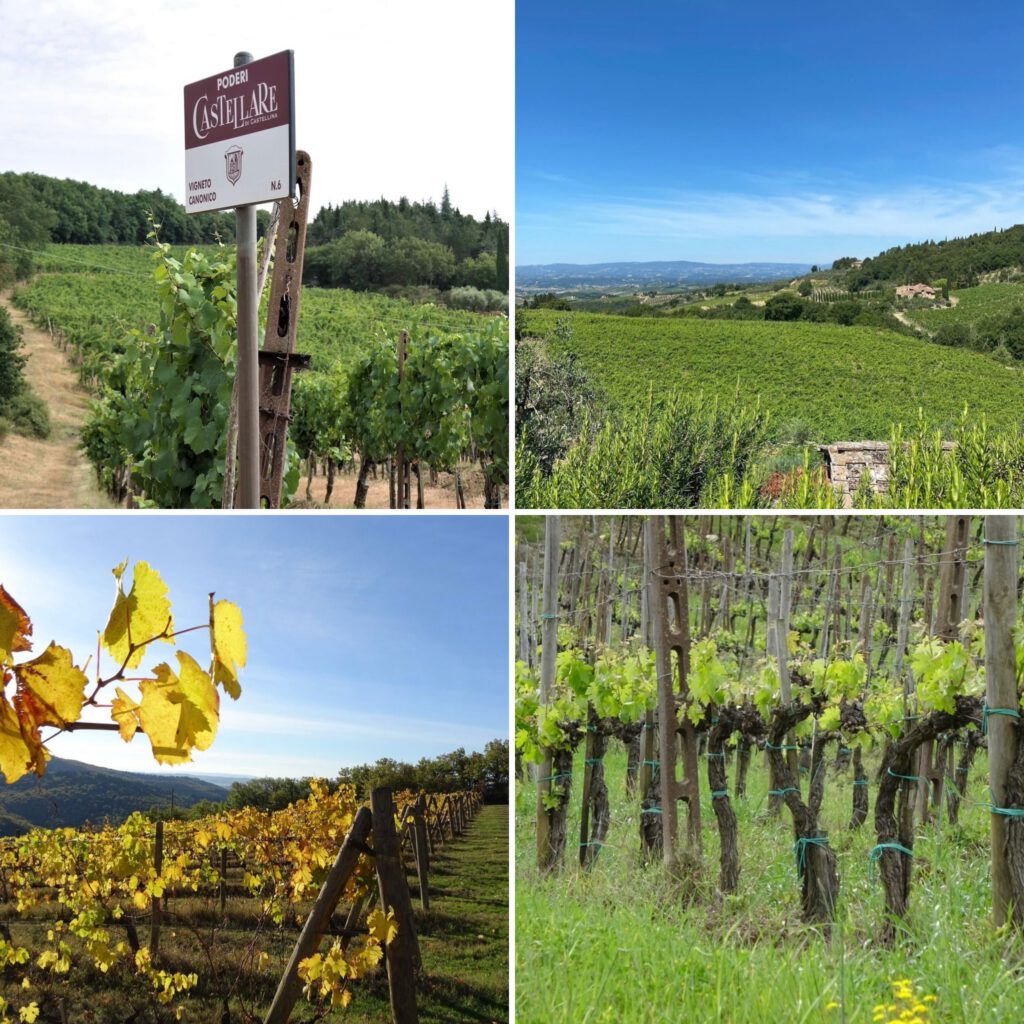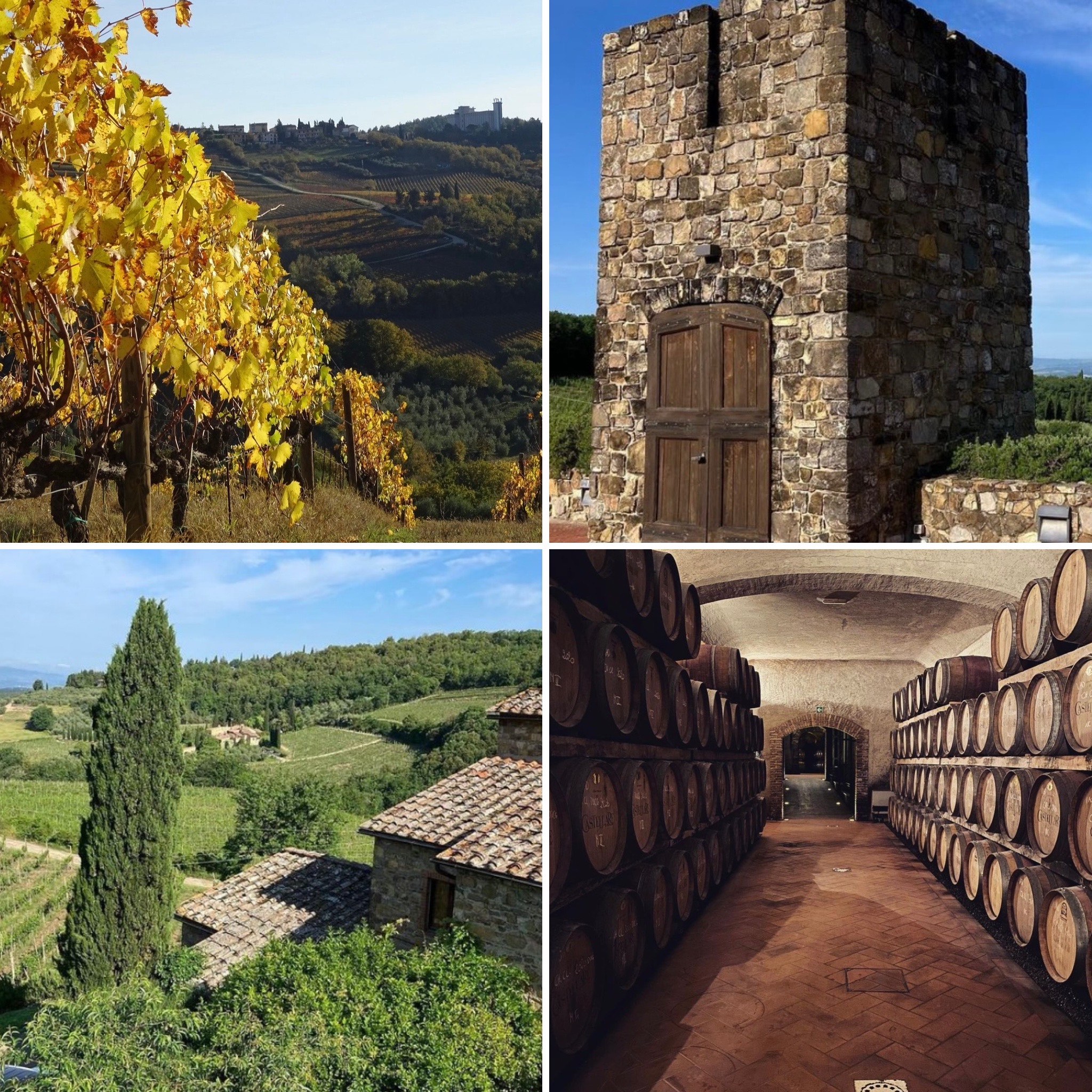Castellare di Castellina: A Testament to Tradition and Innovation in Chianti Classico.
In the heart of Tuscany, where the rolling hills of Chianti Classico unfold in endless vineyards and historic estates, Castellare di Castellina stands as a monument to both the storied past and the bright future of Italian winemaking.
Founded in the 1970s by Paolo Panerai, Castellare di Castellina emerged from the union of four estates: Castellare, Caselle, San Niccolò, and Le Case. This initiative was not just about producing wine; it was about crafting a legacy of unparalleled quality that would resonate through the ages.
The estate’s journey, initiated in the 1970s by Paolo Panerai, is a compelling narrative of how tradition, innovation, and a profound respect for nature can converge to produce wines of unmatched quality and depth.
The Birth of a Renaissance
The 1970s marked the dawn of what many refer to as the Renaissance of Italian wine, a period of rebirth and resurgence that saw Italian winemakers reaching new heights of quality and recognition. Castellare di Castellina was at the forefront of this movement, embracing a philosophy that intertwined the rich traditions of Tuscan winemaking with a forward-thinking approach to viticulture and oenology.
Tradition and Innovation: The Core Philosophy
The ethos of Castellare di Castellina is built on a dual foundation: deep respect for tradition and a relentless pursuit of innovation. The estate’s commitment to tradition is evident in its meticulous care for the vineyards, where the land is revered and understood in its dual aspects: the easily worked “fields” and the more challenging “sodi” or “hard” soils, which, despite their name, are considered the best for cultivating vines. This distinction highlights the estate’s dedication to producing wines in the true Tuscan method, honoring the Chianti Classico denomination by using only indigenous Tuscan grape varieties.
Innovation at Castellare di Castellina has been equally pivotal. The estate pioneered the first experimental vineyard in the Chianti region in collaboration with the University of Milan and the University of Florence. This groundbreaking initiative focused on the scientific selection of Sangiovese clones, locally celebrated as Sangioveto. Furthermore, under the guidance of the legendary oenologist Emile Peynaud, Castellare introduced the use of barriques, marrying traditional methods with contemporary techniques to enhance the complexity and character of their wines.
The soul of Castellare di Castellina is deeply connected to the land and its history. The winery pays homage to the Mezzadri, the people who historically managed these estates in a unique system that positioned them between owners and laborers. Their hard work and dedication have sculpted the extraordinary landscape of Chianti.
The Evolution of Castellare di Castellina
Castellare di Castellina’s journey from its humble beginnings to becoming a modern winemaking leader illustrates its remarkable evolution and dedication to winemaking excellence. This transformation involved not only expanding its production capabilities to approximately 400,000 bottles annually but also integrating state-of-the-art technologies while maintaining the integrity of its historical architecture and aesthetics.
Initially, the winery relied on concrete tanks for fermentation, with an annual production of around 200,000 bottles. The introduction of heat-treated steel vinification tanks marked a pivotal shift in its winemaking process, leading to the development of a new winery facility. This facility was designed to complement the traditional Tuscan architectural style of its ancient buildings. Guided by the advice of Giacomo Tachis, a celebrated Italian winemaker, Castellare di Castellina not only preserved its original concrete tanks but also enhanced them with a glazing technique. These tanks, adhering to Tachis’s philosophy, now serve a crucial role in the maturation process, storing wine for several months before bottling to improve its overall harmony and character. This method exemplifies the winery’s successful fusion of heritage and innovation to elevate wine quality.
Moreover, Castellare di Castellina pioneered the adoption of small French oak barrels, or barriques, in Italy. This strategic move represented a significant advancement in winemaking technology, embracing the finest practices to refine the complexity and profile of its wines.

Exploring the Unique Terroir of Castellare di Castellina’s Vineyards
Castellare di Castellina’s sprawling 80-hectare estate, with 33 hectares devoted to vineyards and 20 to olive groves, showcases its unwavering commitment to both quality and environmental sustainability. The vineyards benefit from a prime location on southeast-facing slopes, resembling a natural amphitheater, at an elevation of 370 meters. This strategic positioning affords the vines optimal sunlight, superior drainage, and a soil blend rich in limestone marl, galestro, and clay—factors that collectively forge an ideal setting for vine growth.

In an innovative move, Castellare di Castellina launched a collaborative research initiative with the University of Milan and the University of Florence, resulting in the region’s first experimental vineyard. This project focused on scientifically selecting clones of Sangiovese (referred to locally as Sangioveto) and Malvasia Nera. This collaboration led to the discovery of clones best suited to the estate’s distinct terroir, emphasizing the importance of aligning vine varieties with their specific growing conditions to enhance the expression of the estate’s unique characteristics.
The deliberate selection of Sangioveto underscores the adaptability of the Sangiovese grape to its environment and the necessity of a precise match between vine and terroir, ensuring that the vineyard thrives with clones optimally expressing the estate’s distinctive landscape nuances. Moreover, the vineyard’s age range, from 7 to over 45 years, combined with deliberately low yields, reflects Castellare di Castellina’s dedication to prioritizing quality above quantity.

Such meticulous vineyard management practices yield well-structured and richly flavored wines, both red and white, with significant aging potential, further solidifying the estate’s reputation for producing exemplary wines that encapsulate the essence of their unique terroir.
A Commitment to Sustainability
Castellare di Castellina’s approach to viticulture is characterized by an unwavering respect for the environment. Synthetic chemicals are eschewed in favor of organic practices, ensuring the health of the vineyard and the surrounding ecosystem. This philosophy extends to the winery’s labels, which annually feature a different bird species found on the estate, symbolizing the winery’s dedication to preserving biodiversity and highlighting the impact of indiscriminate chemical use in agriculture.
Castellare di Castellina’s Wine Portfolio: A Testament to Excellence
Castellare di Castellina’s wines embody a harmonious blend of tradition, innovation, and dedication to environmental sustainability, capturing the quintessential essence of the Chianti Classico region. The winery’s meticulous vineyard management and commitment to eco-friendly practices throughout its production processes reflect a deep respect for the land and its heritage. By focusing exclusively on indigenous Tuscan grape varieties, Castellare di Castellina not only honors the area’s winemaking traditions but also showcases the distinctiveness of its terroir, affirming its status as a benchmark for quality in the global wine industry.
The winery’s selection epitomizes the spirit and character of Chianti Classico. At the forefront of its offerings is the Chianti Classico, a wine that perfectly captures the Sangiovese grape’s essence, distinguished by its vibrant cherry and earthy flavors, well-structured tannins, and lively acidity. Beyond its flagship, Castellare di Castellina produces an array of single-vineyard and reserve wines, each narrating the unique story of its provenance. Among these, the “I Sodi di San Niccolò” is particularly noteworthy. This exceptional blend of Sangiovese and Malvasia Nera has garnered international praise for its intricate complexity, refined elegance, and notable longevity, further solidifying the winery’s reputation for crafting wines of unparalleled quality and depth.
For this article we are shining the spotlight on the 2016 vintage of Castellare di Castellina’s flagship wine:
I Sodi di San Niccolò 2016
The wine presents an intense red hue tinged with hints of garnet, suggesting both depth and maturity. Upon pouring, it reveals a multifaceted bouquet that intricately weaves together aromas of inky dark fruit, such as wild cherry and dried raspberry, with Mediterranean nuances of rosemary and crushed lavender. These primary scents are beautifully complemented by layers of spice, licorice, gravel, and a whisper of menthol, showcasing the wine’s exceptional clarity and focus.
The palate mirrors the complexity found on the nose, with a rush of blueberry and blackberry at the forefront, seamlessly blending with subtle notes of walnuts. Each sip unfolds a rich, juicy texture, underscored by a tight structure that promises longevity. The integration of Sangioveto and Malvasia Nera results in elegant, finely-knit tannins and a polished, long-lasting finish. Remarkable for its purity and focus, the wine also reveals hints of cassis, enhancing its layered complexity.
Conclusion:
The 2016 I Sodi di S. Niccolò is a standout vintage, one of the finest in its two decades of production. It demands patience, with a potential that will only unfold with time in the bottle. Yet, even at this early stage, it is nothing short of spectacular, proving to be one of the most outstanding expressions of this iconic wine over the past two decades. Returning to the wine after it has been opened for a day reveals an even more captivating character, indicating not only its immediate allure but its capacity for graceful evolution.
This wine is not only a reflection of the meticulous vinification and refinement processes but also a testament to the unique terroir of its vineyard. It showcases the excellence of the Sangioveto and Malvasia Nera blend, embodying the essence of its Tuscan origins.
This Chianti red earns its place as a high-end, yet profoundly underappreciated, Tuscan treasure. We happily award this gem with a 95-point DWA score.

Conclusion
Castellare di Castellina is more than a winery; it is a beacon of how tradition and innovation can coalesce to draw the best from the land. It is a story of dedication, passion, and respect for the past, while boldly looking to the future. As Castellare di Castellina continues to produce wines that are internationally recognized among the greatest reds in the world, it stands as a testament to the timeless beauty and enduring spirit of Chianti Classico.
This article is written by our own Niels Aarts. Castellare di Castellina is exported to a number of foreign markets and well distributed. In the Netherlands their wines can be bought through Henri Bloem and Herman Wines. Additionally, the wines can be bought directly at the estate.

